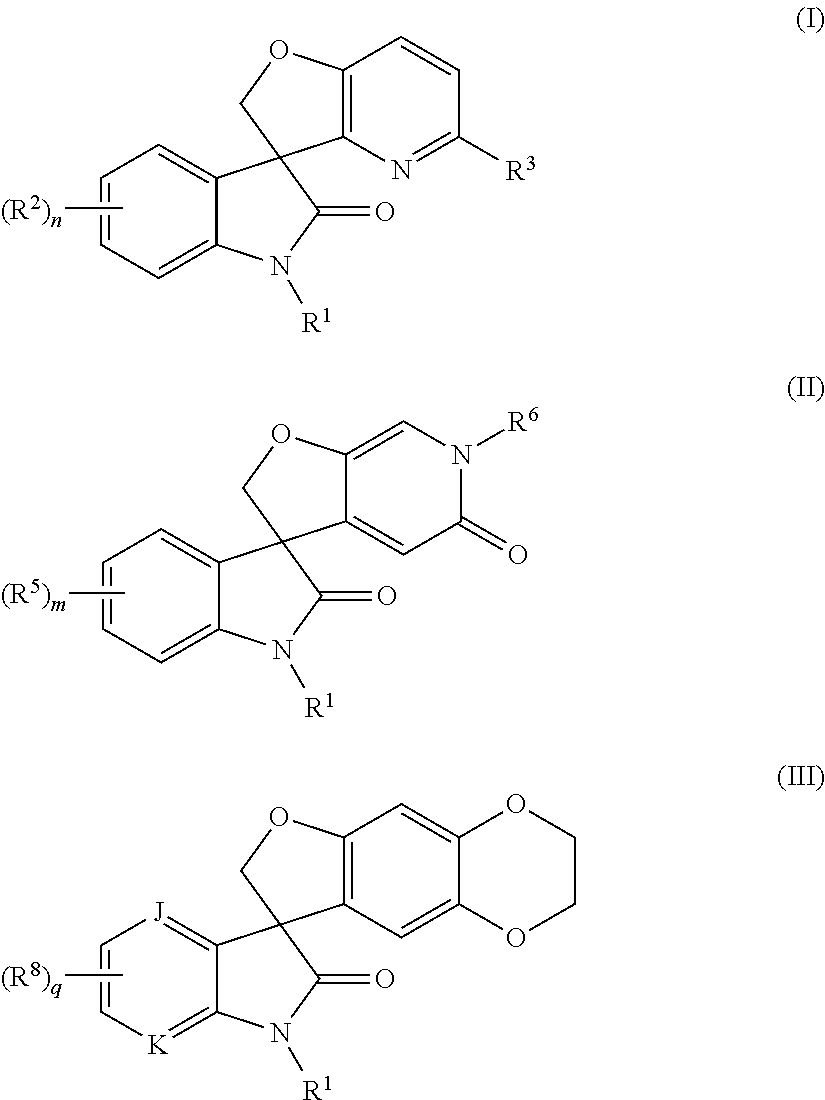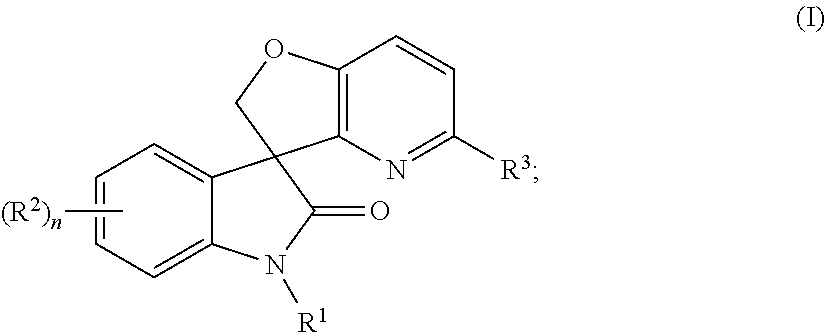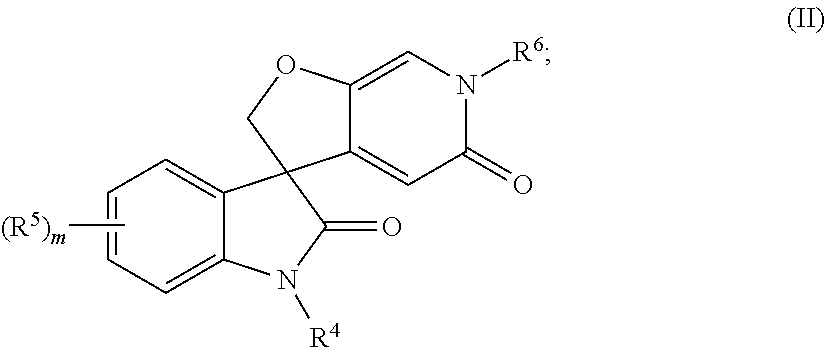Spiro-oxindole-derivatives as sodium channel blockers
a sodium channel blocker and derivative technology, applied in the field of spiro-oxindole compounds, can solve the problems of major pathophysiological conditions, major changes, and insufficient potency and therapeutic index of these blockers, and achieve the effect of reducing adverse events and increasing the potency of existing or future drug therapies
- Summary
- Abstract
- Description
- Claims
- Application Information
AI Technical Summary
Benefits of technology
Problems solved by technology
Method used
Image
Examples
preparation 1
Synthesis of 1-(diphenylmethyl)-3-(7-hydroxy-2,3-dihydro-1,4-benzodioxin-6-yl)-1,3-dihydro-2H-pyrrolo[3,2-b]pyridin-2-one
A. Synthesis of 1-(diphenylmethyl)-1H-pyrrolo[3,2-b]pyridine
[0252]To a solution of 1H-pyrrolo[3,2-b]pyridine (10.0 g, 84.7 mmol) in N,N-dimethylformamide (100 mL) was added sodium hydride (60% w / w dispersion in mineral oil, 2.24 g, 65.3 mmol) in small portions at 0° C. The reaction mixture was stirred at ambient temperature for 1 h and a solution of bromodiphenylmethane (22.0 g, 88.9 mmol) in N,N-dimethylformamide (50 mL) was added dropwise at 0° C. The reaction mixture was stirred at ambient temperature for 17 h and water (400 mL) was added at 0° C. The mixture was filtered and the filter cake was washed with ethyl acetate (3×100 mL). The filtrate was transferred to a separatory funnel and the aqueous layer was extracted with ethyl acetate (3×200 mL). The combined organic extracts were washed with water and brine, dried over anhydrous sodium sulfate, filtered and...
preparation 2
Synthesis of 1-(diphenylmethyl)-3-(7-hydroxy-2,3-dihydro-1,4-benzodioxin-6-yl)-1,3-dihydro-2H-pyrrolo[2,3-b]pyridin-2-one
A. Synthesis of 1-(diphenylmethyl)-1H-pyrrolo[2,3-b]pyridine
[0257]Following the procedure as described in PREPARATION 1A, and making non-critical variations using 1H-pyrrolo[2,3-b]pyridine to replace 1H-pyrrolo[3,2-b]pyridine, 1-(diphenylmethyl)-1H-pyrrolo[2,3-b]pyridine (30%) was obtained as a colorless solid: 1H NMR (400 MHz, CDCl3) δ 8.34-8.32 (m, 1H), 7.96-7.93 (m, 1H), 7.53 (d, J=3.6 Hz, 1H), 7.39-7.26 (m, 6H), 7.17-7.07 (m, 6H), 6.49 (d, J=3.6 Hz, 1H); MS (ES+) m / z 285 (M+1).
B. Synthesis of 3,3-dibromo-1-(diphenylmethyl)-1,3-dihydro-2H-pyrrolo[2,3-b]pyridin-2-one
[0258]To a solution of 1-(diphenylmethyl)-1H-pyrrolo[2,3-b]pyridine (42.6 g, 0.15 mol) in tert-butanol (2500 mL) was added pyridinium tribromide (140 g, 0.44 mol) in small portions at ambient temperature. The reaction mixture was stirred at 40° C. for 3 h. Further pyridinium tribromide (32.0 g, 0.10 ...
example 1
Synthesis of 4′-bromo-5-methoxy-1′-[(2R)-tetrahydrofuran-2-ylmethyl]spiro[furo[3,2-b]pyridine-3,3′-indol]-2′(1′H)-one
[0262]
[0263]To a stirred solution of 4′-bromo-5-methoxyspiro[furo[3,2-b]pyridine-3,3′-indol]-2′(1′H)-one (prepared by the methods described in PCT Published Patent Application WO 2008 / 046049) (1.15 g, 3.3 mmol) in 2-butanone (40 mL) was added cesium carbonate (3.2 g, 9.9 mmol) and (R)-(tetrahydrofuran-2-yl)methyl 4-methylbenzenesulfonate (1.06 g, 4.2 mmol). The reaction was heated at reflux for 4 h, cooled to ambient temperature and filtered. The filtrate was concentrated in vacuo and the residue was purified by column chromatography, and eluted with a 20% to 50% gradient of ethyl acetate in hexanes to afford 4′-bromo-5-methoxy-1′-[(2R)-tetrahydrofuran-2-ylmethyl]spiro[furo[3,2-b]pyridine-3,3′-indol]-2′(1′H)-one (1.14 g, 80%) as a colorless solid: mp 110-112° C.; 1H NMR (300 MHz, DMSO-d6) δ 7.35 (dd, J=8.8, 1.0 Hz, 1H), 7.30-7.13 (m, 3H), 6.65 (d, J=8.9 Hz, 1H), 4.94 ...
PUM
| Property | Measurement | Unit |
|---|---|---|
| body weight | aaaaa | aaaaa |
| temperature | aaaaa | aaaaa |
| temperature | aaaaa | aaaaa |
Abstract
Description
Claims
Application Information
 Login to View More
Login to View More - R&D
- Intellectual Property
- Life Sciences
- Materials
- Tech Scout
- Unparalleled Data Quality
- Higher Quality Content
- 60% Fewer Hallucinations
Browse by: Latest US Patents, China's latest patents, Technical Efficacy Thesaurus, Application Domain, Technology Topic, Popular Technical Reports.
© 2025 PatSnap. All rights reserved.Legal|Privacy policy|Modern Slavery Act Transparency Statement|Sitemap|About US| Contact US: help@patsnap.com



